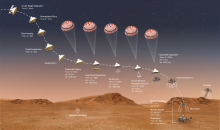Listen to today's episode of StarDate on the web the same day it airs in high-quality streaming audio without any extra ads or announcements. Choose a $8 one-month pass, or listen every day for a year for just $30.
You are here
Heading for Mars III
NASA’s next Mars rover will have a lot on its plate. It will scour an ancient lakebed for signs of life. It’ll carry a small helicopter to help scout its path. It’ll gather about 30 samples for possible return to Earth by a follow-up mission. And if that’s not enough, it’ll also try to extract oxygen from the atmosphere as a test for future human exploration of Mars.
The launch window for the Perseverance rover opens this week. And if all goes well, the craft will arrive at Mars in February. It will touch down in Jezero Crater. Billions of years ago, the crater contained a deep lake. The lake could have persisted for millions of years, making it a good place to look for evidence of past life.
Perseverance will use several instruments to study the crater floor — particularly an ancient river delta, where water flowed into the crater. The instruments can identify organic compounds — the chemistry of life.
The rover also will carry a weather station, 23 cameras, and the helicopter. The tiny chopper is there to demonstrate the technology. But controllers on Earth may use some of its pictures to help plan the rover’s path.
Perseverance also will seal some samples of the Martian dirt, and core samples drilled below the surface, for return to Earth in a few years. Plans call for another rover to land nearby, pick up the samples, and place them on a rocket for the journey to Earth — capping the most ambitious Mars mission to date.





